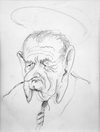
Peter Hurd (1904-1984) Biography
Peter Hurd is best known for his egg tempera paintings of New Mexico landscapes and ranch life.
He was born Harold Hurd, Jr on February 22, 1904 in Roswell, New Mexico, but his parents called him Pete from an early age. (He later legally changed his name to "Peter.") Hurd's father came from a prominent Boston family and had established a law practice in New York City before moving to southeastern New Mexico for his health. Pete grew up on a small ranch outside of Roswell where he explored the arid terrain of arroyos and mesas, forming a bond with the land that would last throughout his life and career.
Hurd attended high school at the New Mexico Military Academy in Roswell and then won appointment to the U.S. Military Academy at West Point in 1921. He he came to realize that the rigors of military life did not suit him, but increasingly found satisfaction in drawing and painting. The sale of one of his paintings to a West Point superior perhaps gave him courage to resign the Academy in good standing and pursue an art education.
In 1923 Hurd enrolled in Haverford College near Philadelphia, and in December of that year he sought out the famous illustrator, N.C. Wyeth, at his home in Chadds Ford, Pennsylvania. The following year, Hurd left college to become Wyeth's private student, taking up residence in the family's barn. Wyeth warned the aspiring painter that being his student would be tougher than attending West Point, and Hurd later admitted the truth of the comment. Hurd also attended the Pennsylvania Academy of Fine Art in 1924 at Wyeth's urging.
By all accounts, the entire Wyeth family was charmed by the skinny westerner who continued to wear his cowboy hat and boots in the staid social environment of Chadds Ford. He apparently made the biggest impression, however on Wyeth's oldest child, Henriette, and the two were married in 1929. Peter and Henriette, herself an excellent painter, continued studying with the elder Wyeth until the lure of Hurd's home territory drew them to New Mexico in 1934. They bought a property they named Sentinel Ranch at the tiny village of San Patricio, where they lived the rest of their lives.
Hurd came to national attention in the 1930s for both painting and book illustration. Among the books areLast of the Mohicans(1926),Great Stories of the Sea and Ships(1933), and Habit of Empire(1938). Nevertheless, he was most associated with the New Mexico subjects which occupied most of his career. He worked primarily in egg tempera on gesso, a medium he introduced to his younger brother-in-law, Andrew Wyeth.
Hurd's realist palette and brush technique of fine, linear marks and hatches beautifully conveyed the scrubby high-desert landscape. He loved to explore the visual effect of constantly changing weather and sunlight on the land. Hurd also was known for his honest yet sympathetic portrayals of local ranch and farm families going about the work and pleasures of their daily lives.
Sponsored by New Deal art programs, Heard painted murals for the Big Springs, Texas Post Office in 1938 and the Terminal Annex Building in Dallas in 1940. In that latter year he also completed three fresco murals at the Alamagordo, New Mexico Post Office. From 1942 to 1945 Hurd worked as a war correspondent forLifemagazine and then resumed full-time painting. During 1953 and 1954 Peter, Henriette, and two students, Manuel Acosta and John Meigs, painted a fresco mural in the rotunda of what was then the West Texas Museum at Texas Technical College (now Texas Tech) at Lubbock.
In 1957, Hurd released an album,Spanish Folk Songs of New Mexico,a collection of ranchera songs. The next year he was appointed to the President's Commission of Fine Arts, and in 1967 was commissioned to paint the portrait of Lyndon Johnson. The President rejected the finished work declaring it "the ugliest thing I ever saw." It now hangs in the National Portrait Gallery in Washington.






